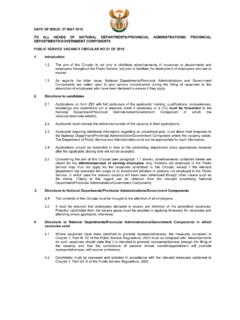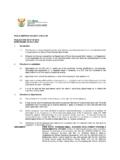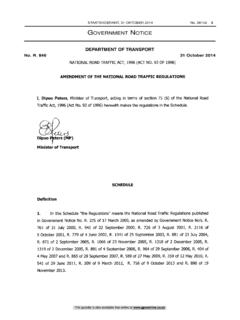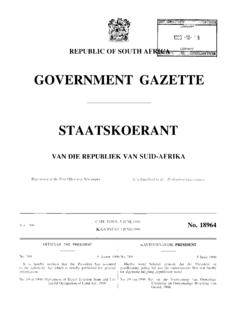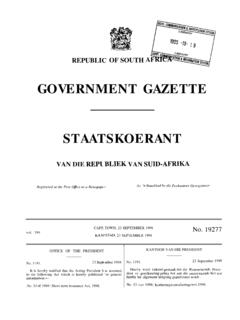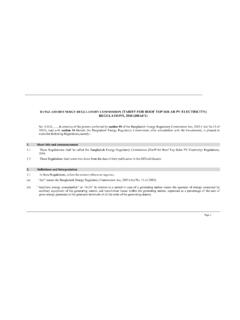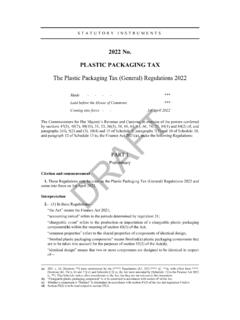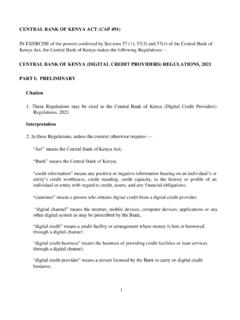Transcription of Employment Equity Act: Regulations: Comments invited
1 PUBLICATION OF THE draft Employment Equity regulations , 2018 (herein referred as EE regulations , 2018) FOR PUBLIC COMMENT I Mildred Nelisiwe Oliphant, Minister of Labour, in terms of Section 55(1) of the Employment Equity Act, 1998 (Act No 55 of 1998 as amended), and on the advice of the Commission for Employment Equity , hereby publish draft Employment Equity regulations made in terms of the Employment Equity Act, Act 55 of 1998, for public comment. o m cn 2- m .-. This gazette is also available free online at No. 41923 GOVERNMENT GAZETTE, 21 SEPTEMBER 2018 Government notices GoewermentskennisGewinGsLabour, Department of/ Arbeid, Departement vanDEPARTMENT OF LABOURNO. 993 21 SEPTEMBER 2018993 Employment Equity Act (55/1998), as amended: Employment Equity regulations , 2018: For public comment 41923 This gazette is also available free online at STAATSKOERANT, 21 SEPTEMBER 2018 No.
2 41923 5 draft Employment Equity regulations , 2018 I,Mildred Nelisiwe Oliphant, Minister of Labour, hereby under section 55(1) of the Employment Equity Act, 1998 (Act 55 of 1998 as amended), publish the draft Employment Equity regulations in the schedule. SCHEDULE Arrangement of regulations Definitions of Equal Value2. Equal Pay for Work of Equal Value unfair discrimination4. Meaning of work of equal Assessing whether work is of equal value7. Factors justifying differentiation in terms and conditions of employmentDuties of a Designated Employer7A. Determination of numerical targets 8. Collecting information and conducting an analysis9. Duty to prepare and implement an Employment Equity to report11. Duty to informEnforcement Mechanisms12. Income differentials and discrimination13. Requesting an undertaking14. Compliance order14A Service of compliance order15. Review by the Director-General (DG Review)General Administrative Matters 16.
3 Certificate in terms of section of TitleFORMS AND ANNEXURES :Employee declaration in terms of Section 19(1) of the Act :Report to the Director-General in terms of Section 21 of the Act :Summary of the Act in terms of Section 25(1) of the Act :Statement of income differentials in terms of Section 27 of the Act :Request for an undertaking in terms of Section 36 of the Act This gazette is also available free online at No. 41923 GOVERNMENT GAZETTE, 21 SEPTEMBER :Compliance order in terms of Section 37(1) of the Act :DG Review Assessment Form in terms of Section 43 of the Act :Demographic Data in terms of Section 42 of the Act :Occupational Levels in terms of Section 21 of the Act : Summary of the Employment Equity progress report in terms of Section 22 of the Act11. EEA11: Request for employer s Employment Equity report in terms of Section 21(5) of the : Template for reporting on analysis conducted in terms of Section 19 of the 13: Template for Employment Equity Plan in terms of Section 20 of the 14: Director-General Notification in terms of Section 21(4A) of the 15: Request for an EE Compliance 16A: EE Compliance Certificate for designated 16B: EE Compliance Certificate for non-designated 17: Economic Sectors and Sub-Sectors1.
4 DefinitionsIn these regulations any word or expression to which a meaning has been assigned in the Act, has themeaning so assigned and, unless the context otherwise indicates.[ Basic Conditions of Employment Act means the Basic Conditions of Employment Act, 1997 (ActNo. 75 of 1997), as amended; ] Department means the Department of Labour Labour Relations Act means the Labour Relations Act, 1995 (Act No. 66 of 1995), as amended; listed ground means a ground listed in terms of section 6(1) of the Act; National Minimum Wage Commission as established in terms of the National Minimum Wage Act,2018 (Act No. __ of 2018), as amended; Regional demographics means the Provincial Economically Active Population; temporary employees mean employees who are employed for less than three months; the Act means the Employment Equity Act, 1998 (Act No. 55 of 1998), as amended; and work of equal value includes works that is the same, substantially the same or of the same value asother work, as contemplated in regulation 4 of these Equal Pay for Work of Equal Value CriteriaThese regulations are published to prescribe the criteria and methodology for assessing work of equalvalue contemplated in section 6(4) of the Eliminating unfair discrimination(1)An employer must, in order to eliminate unfair discrimination, take steps to eliminate differencesin terms and conditions of Employment , including remuneration of employees who perform workThis gazette is also available free online at STAATSKOERANT, 21 SEPTEMBER 2018 No.
5 41923 7of equal value if those differences are directly or indirectly based on a listed ground or any arbitrary ground that is prohibited by section 6(1) of the Act. (2)Without limiting sub-regulation (1), an employer must ensure that employees are not paiddifferent remuneration for work of equal value based on race, gender or Meaning of work of equal valueFor the purpose of these regulations , the work performed by an employee (1)is the same as the work of another employee of the same employer, if their work is identical orinterchangeable;(2)is substantially the same as the work of another employee employed by that employer, if the workperformed by the employees is sufficiently similar that they can reasonably be considered to beperforming the same job, even if their work is not identical or interchangeable;(3)is of the same value as the work of another employee of the same employer in a different job, iftheir respective occupations are accorded the same value in accordance with regulations 5 to MethodologyWhen, applying section 6(4) of the Act (1)it must first be established(a) whether the work concerned is of equal value in accordance with regulation 6; and(b) whether there is a difference in terms and conditions of Employment , including remuneration.
6 (2)it must then be established whether any difference in terms of sub-regulation (1)(b) constitutesunfair discrimination, applying the provisions of section 11 of the Assessing whether work is of equal value(1)In considering whether work is of equal value, the relevant jobs must be objectively assessedtaking into account the following criteria:(a) the responsibility demanded of the work, including responsibility for people, finances andmaterial;(b)the skills, qualifications, including prior learning and experience required to perform the work,whether formal or informal;(c) physical, mental and emotional effort required to perform the work; and(d) to the extent that it is relevant, the conditions under which work is performed, includingphysical environment, psychological conditions, time when and geographic location wherethe work is performed.(2)In addition to the criteria specified in sub-regulation (1) any other factor indicating the value of thework may be taken into account in evaluating work, provided the employer shows that the factoris relevant to assessing the value of the gazette is also available free online at No.
7 41923 GOVERNMENT GAZETTE, 21 SEPTEMBER 2018(3)The assessment undertaken in terms of sub- regulations (1) and (2) must be conducted in amanner that is free from bias on grounds of race, gender or disability, any other listed ground orany arbitrary ground that is prohibited in terms of section 6(1) of the Act.(4)Despite sub- regulations (1) and (2), an employer may justify the value assigned to an employee swork by reference to the classification of a relevant job in terms of a sectoral determination madeby the Minister of Labour in terms of section 55 of the Basic Conditions of Employment Act, 1997(Act No. 75 of 1997) which applies to the Factors justifying differentiation in terms and conditions of Employment (1)If employees perform work that is of equal value, a difference in terms and conditions ofemployment, including remuneration, is not unfair discrimination if the difference is fair and rationaland is based on any one or a combination of the following grounds:(a)the individuals respective seniority or length of service;(b)the individuals respective qualifications, ability, competence or potential above the minimumacceptable levels required for the performance of the job;(c)the individuals respective performance, quantity or quality of work, provided that employeesare equally subject to the employer s performance evaluation system, that the performanceevaluation system is consistently applied.
8 (d)where an employee is demoted as a result of organisational restructuring or for any otherlegitimate reason without a reduction in pay and fixing the employee s salary at this level untilthe remuneration of employees in the same job category reaches this level;(e)where an individual is employed temporarily in a position for purposes of gaining experienceor training and as a result receives different remuneration or enjoys different terms andconditions of Employment ;(f)the existence of a shortage of relevant skill, or the market value in a particular jobclassification; and(g)any other relevant factor that is not unfairly discriminatory in terms of section 6(1) of the Act.(2)A differentiation in terms and conditions of Employment based on one or more grounds listed insub-regulation (1) will be fair and rational if it is established, in accordance with section 11 of theAct, that (a)its application is not biased against an employee or group of employees based on race,gender or disability or any other ground listed in section 6(1) of the Act; and(b)it is applied in a proportionate Determination of numerical targets for national economic sectors in terms of section 15A This gazette is also available free online at STAATSKOERANT, 21 SEPTEMBER 2018 No.
9 41923 9(1)For the purpose of determining a numerical target in terms of section 7A, any relevant criteriamay be taken into account including (a)the qualification, skills, experience [ and the capacity to acquire, within a reasonabletimeframe, the ability to do the job];(b)the rate of turn-over and natural attrition within a sector;(c)recruitment and promotional trends within a sector.(2)For the purpose of determining numerical target in terms of section 7A, employers must refer toeconomic sectors and sub-sectors contained in the EEA17 for of a designated employer 8. Collecting information and conducting an analysis(1)When a designated employer collects information contemplated in section 19 of the Act, theemployer must request each employee in the workforce to complete a declaration using theEEA1 form.(2)An employee may add information to the EEA1 form.(3)Where an employee refuses to complete the EEA1 form or provides inaccurate information, theemployer may establish the designation of an employee by using reliable historical and existingdata.
10 People with disabilities have the right not to declare their disability, unless it is in line withthe inherent requirements of the job.(4)A designated employer must conduct an analysis as required by section 19 of the Act byreviewing its workforce profile and Employment policies, practices, procedures and the workingenvironment in order to identify Employment barriers which adversely affect people fromdesignated groups from being equitably represented across all occupational levels. The outcomeof the analysis should be reported using the EEA12 in these regulations .(5)A designated employer must refer to the relevant Codes of Good Practice issued in terms ofsection 54 of the Act as a guide when collecting information and conducting the analysis requiredby section 19 of the Act.(6)When a designated employer conducts the analysis as required by section 19 of the Act, theemployer may refer to (a)EEA8, a guide on the applicable national and regional economically active population (EAP); and(b)EEA9, which contains a description of occupational Duty to prepare and implement an Employment Equity Plan(1)A designated employer must refer to the relevant Codes of Good Practice issued in terms ofsection 54 of the Act when preparing an Employment Equity Plan contemplated in section 20 of gazette is also available free online at No.
